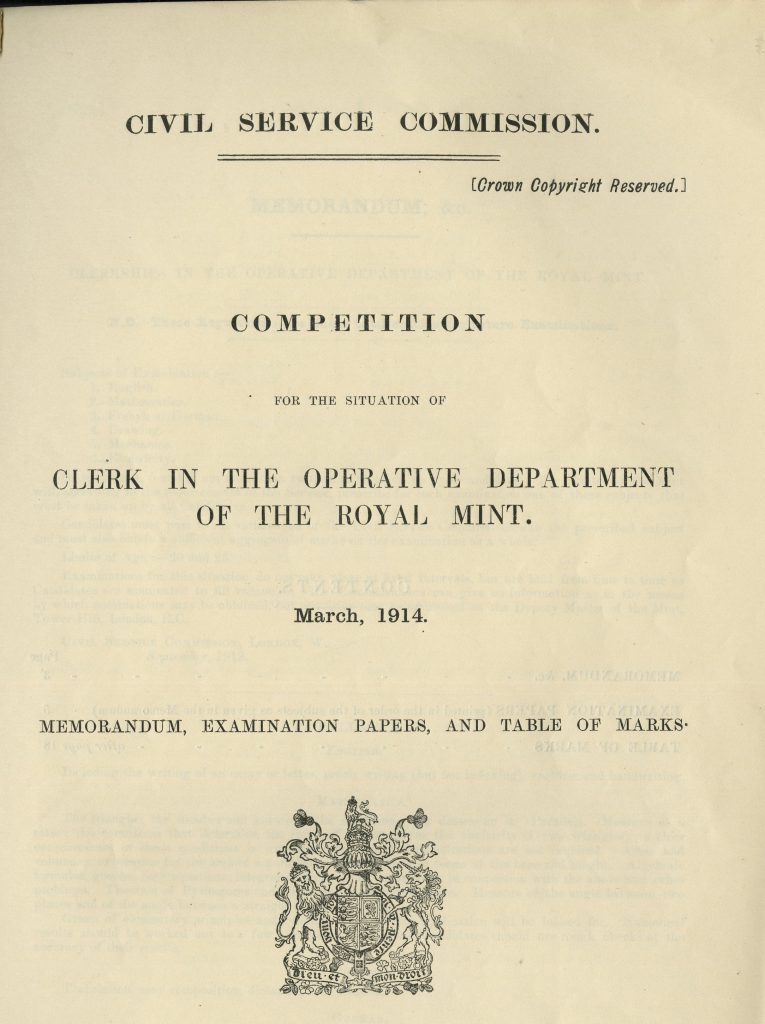
Ahead of the summer holidays and a well-deserved break, many of us will be either finishing exams or perhaps know someone who is. But spare a thought for the young men who wished to become clerks in The Royal Mint Operative Department back in 1914. Our Museum team recently shared this exam paper from 1914, still in immaculate condition, that clerks had to sit to be considered for the position.

The men had to sit examination papers in English, Maths, French or German, and either Drawing, Mechanics or Electricity. In addition, an oral test included dictation in French and German. The range of topics included in the test provide an interesting glimpse into the political, social and technological outlook of the times and would have offered the candidates an opportunity to play to their strengths.
The entrant who came through with the highest score that year, a very creditable 1405 out of a possible 1800, was 22-year-old Harold Ernest Williams, a university graduate with a BSc. He could now have expected a bright future at the Mint as many senior Mint officials had begun their careers in a similar position. His service began on 20 April 1914 and he shared his time between the Cutting Room and the Weighing Room but just over a year later his career at the Mint was cut short. He joined up for war service in the Army and tragically he was killed in action on 20 September 1917.
Do you think you could have had what it takes to sit The Royal Mint clerks exam? Here’s a selection of questions from the paper:
English
Choose one of the following subjects:-
The advantages and the disadvantages to England of entering into a definite alliance with France.
Discuss the objections raised to picture-houses
The relative advantages of gas light and electric light in the home
Mathematics
Every year the population of a certain town is multiplied by a certain constant numerical factor n, slightly greater than 1. The present population is 85,000, and 20 years ago it was 60,000. With the aid of logarithms determine the value of n, and hence state the rate of increase of population per thousand per annum. After what number of years will the population of the town first exceed 1,000,000?
If one angle of a right-angled triangle is 450, prove that the triangle is isoceles, and determine the ratio of the hypotenuse to one of the equal sides.
A straight wall 6ft. high and 20 yards long, standing vertically upon horizontal ground, runs due north and south. Calculate the area in square yards of the shadow of the wall upon the ground when the sun is in the south-west and its angular elevation is 450
Determine also by geometrical construction and measurement the inclination to the horizontal of that plane which contains the top edge of the wall and the corresponding boundary of the shadow.
Drawing
Show, by careful sectional sketches, the construction of a pair of bevel wheels. Mark one or two of the chief proportions on your sketches
Give sketches of a simple form of footstep bearing and show how it may be adjusted in any direction.
Mechanics
Construct a curve to show the piston velocity at all parts of the two strokes of a direct-acting horizontal steam engine. Length of crank 1 foot, connecting rod 3ft 6in. The crank rotates uniformly at 150 per minute. State the scale of your velocity curve.
From the velocity curve construct an acceleration diagram for one stroke of the engine.
Electricity
Show how a wireless message may be received in such a way that-
(a) the message may be printed off in dots and dashes on a tape;
(b) long and short buzzes may be heard in a telephone.
Sketch the essentials of a complete elementary telephone circuit suitable for long distances. State the uses of each pieces of apparatus.
Discover great stories from history and how we're celebrating these moments within The Royal Mint
Read more
